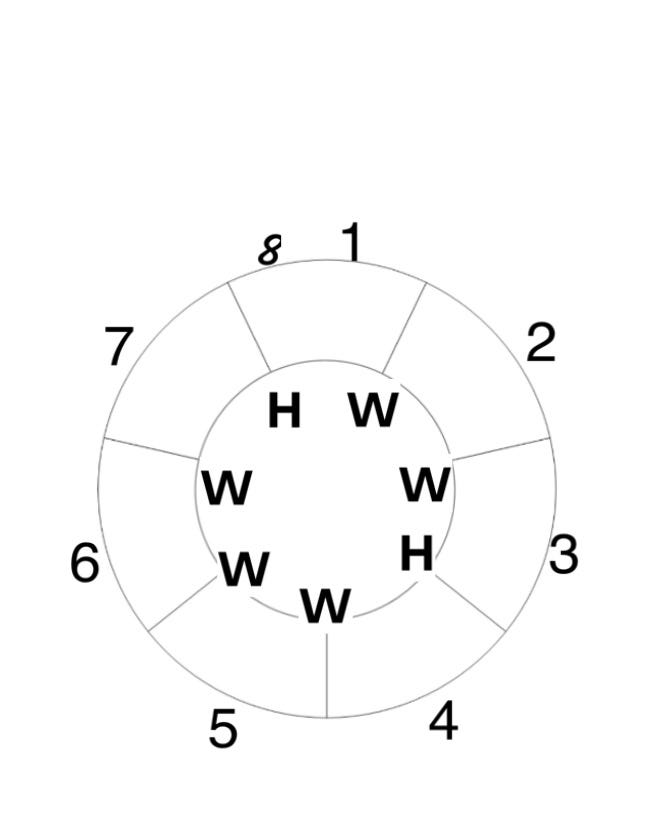Today let’s take a musical scale, any scale, and transform it into a key!! While the term “key” in this case refers to the set of chords we can build from any scale, it may also be thought of as a way to further unlock the musical “language” we use to communicate with other musicians!!
To start we’ll use a modified graphic from last week’s newsletter:
This is a .jpg (picture) you can copy and print to practice with.
Today, we’re only going to talk about the most basic chord, the Triad. A triad is a group of 3 notes from scale that sound “good” to our ears when played together. Why? For some reason (and that reason may be nothing more than the fact that we’re used to hearing them together as “good”, or it may be something more metaphysical - I’m just going to go with “sounds good”) the combination sounds good. The human ear seems to like the sound of “thirds” played together. What’s a “third”? It’s an interval between 2 notes and there are two kinds - a Major third interval and a minor third interval. A few weeks ago I told you we refer to chords in a key as the 1, the 5, the 6, etc, but NOT as the 1st, the 5th, the 6th, etc. That’s because we reserve those designations for the notes within a scale, not the chords within a key. That way we maintain a consistent ability to talk with other musicians without confusion, since the CHORDS in a KEY are referred to by their root NOTES in a SCALE.
As an example, let’s build a chord from notes in a scale. We’ll start with a 1 chord (you can use a Roman Numeral as well, in this case a I chord). Since the I chord in a Major scale is always a Major chord, we’ll start with that. A Major chord is built from a Major third interval and a minor third interval. A Major third interval is 2 Whole steps (total: 4 half steps) and a minor third interval is a half step and a Whole step (total: 3 half steps). On our circular chart, we’ll choose a key other than C so we can see the effects of accidental notes (sharps # and flats b). Let’s use the key of D since it’s a common one in popular music.
First, we start with the notes of the D scale:
With D as the root of the scale at the top, the next note is a Whole step away and since D to E is a Whole step, the 2nd is E. But the next note is also a Whole step away, and E to F is only a half step (remember the piano chart from last week? No ebony key between E and F!). So we have to count the next half step using the accidental note to make F#. Now we’ve gone two Whole steps in total, so the interval between D and F# is called a Major third. That makes F# the 3rd of the D scale. We’ll just keep that in mind for a moment.
Next, the interval between the 3rd and 4th is a half step, and because of the # accidental in F#, it’s only a half step to G. Next, we’re back to a whole step interval, so the 5th is A because there is a whole step between G and A (because of the half step G# between them).
Now we’ve gone a minor third between F# and A (a Whole step and a half step = 3 half steps = a minor third). There’s our Triad of 3 notes using our Major third and minor third (written M3 and m3), so we have a Major chord composed of the triad (root, 3rd, 5th) of notes D-F#-A! On the guitar, it looks like this:
Look familiar? If you’re playing a D chord, you’re playing D-F#-A, not in an ascending pitch order, but it doesn’t matter, our ears hear the intervals of Major and minor thirds and we hear a Major chord. If we add the open A string we’ve added another 5th and that just strengthens the triad we hear as a Major D chord. The open E string, if played, will make a chord extension which won’t sound bad, but we’ll talk about extensions to the basic chord triad of 1st, 3rd and 5th in a future newsletter!
That’s probably enough (maybe too much!) theory for today, but if you’re feeling adventurous, use the blank scale circle to figure out different Major scales using the WWHWWWH formula and make some Major chords using the M3,m3 formula from the Root, 4th and 5th notes.
Bonus Round: If you’re feeling especially adventurous turn the formula around to m3, M3 on the 2nd, 3rd and 6th notes of the scale yo find and play some minor chords!!!
Cheers, and keep playing!!
Michael Acoustic





